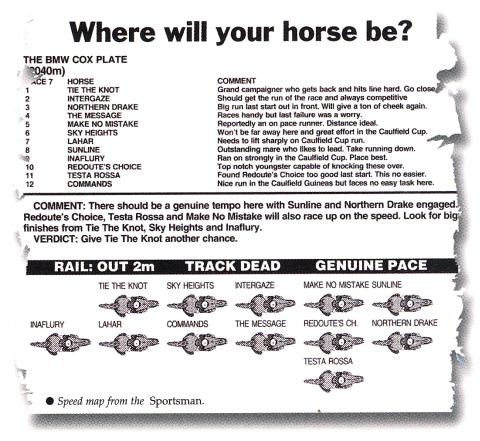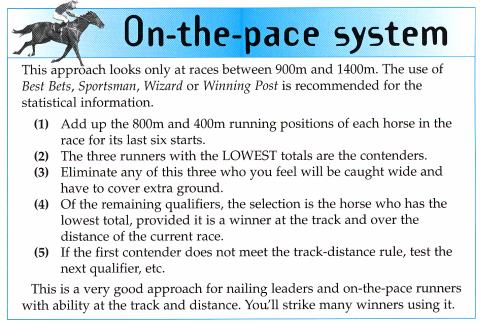How many of us knew that mighty NZ mare Sunline would lead in the Cox Plate? I guess it wouldn't have taken a racing Einstein to figure it out. Yet that one piece of information might well have enabled you to select her as the winner of the great race.
It's much the same with many other races. Find the four or five horses who will be in front on the turn, and you'll be close to getting the winner. Not all the time, but enough times to make the exercise more than worthwhile.
The use of what are known as 'speed maps' is a way of nailing down exactly how a race will be run. Many professionals are now compiling their own speed maps and they report a boost in their success rate.
A friend of mine has been drawing up his own speed maps for the last two years. He tells me there's no way he can do without them.
"They've rejuvenated my whole approach," he says. "I'm now able to clearly focus my observations and by compiling the maps I find I am right 80 per cent of the time when it comes to anticipating how a race will pan out."
Many punters will shun such a task. Much as they shun trying to frame a personal set of prices on a race. They'll say it's too much work. Others, though, especially the punters with a bent towards statistics and close analysis of formlines, will tackle the task with relish.

One man who's made a lifestyle out of compiling speed maps is NSW Thoroughbred Racing Board betting steward Terry Griffin.
He uses information from videos, Sportsman and the excellent Racenet web site to help him draw up his maps.
He also keeps tabs on gear changes and stewards' comments.
To formulate his opinion on the position a horse will attempt to obtain in a race, Griffin concentrates on the positions the horse has taken up in previous races.
He then analyses each horse, taking into account the following key factors:
- Races at the same distance of today's race.
- The horse's racing pattern in this current campaign.
- The barrier draw it has in the race and where it normally settles from either inside or outside barriers.
- The rider engaged for the race, concentrating on races where he has ridden the horse previously.
- Any gear changes, especially blinker changes or the addition of bits.
- Freshness of horse, i.e. what stage of its campaign is it in, early, middle or late.
Says Griffin: "Once all the relevant information has been reviewed, a pattern should become evident of where the horse will attempt to race in this upcoming event.
"The categories I put horses into are: leaders, off-pace, handy, midfield, mid to well back and well back. A shortened version of these positions could be used by all punters as a guide by establishing who will lead and which horses race forward of midfield or worse than midfield."
In drawing up his speed maps,, Griffin goes about 'mapping' the runners to decide who will lead, who'll take a sit just off the pace, and which runners will get well back.
He has a number of basic ideas to establish the map. They are summarised as follows:
- All horses will attempt to obtain their normal and most advantageous position.
- All horses will attempt to get as close to the rails as possible and, if this is not possible, to obtain cover in the run.
- Horses drawn wide control the pace of the race, as it is they who must be aggressive and cross to near the rails. It's easier for runners drawn wide to cross quickly than it is for horses drawn inside, who must 'work' to hold the inside running.
- Runners who are fresh can race closer than their normal pattern. The opposite also applies; as horses tire late in their campaign, their early speed is dulled.
- Horses stepping up in distance can race closer to the lead than in shorter races. The reverse also applies here; when horses drop back in distance they may race further back from the lead than is normal.
- Horses may lead because they are fired up using various gear.
Like other speed map fans, Griffin realises the importance of jockey styles. These play a vital role in the mapping process.
Griffin says: "Jockeys are athletes and have certain skills and habits, like all athletes. Most jockeys have preferred riding styles which must be taken into account when drawing the map.
"Some jockeys prefer to sit midfield or worse and time a big finish but others like to be on the pace whenever possible. These characteristics are most important when deciding what wide-drawn horses will do in the early stages of a race."
The essence of speed maps, then, is to satisfy yourself which runners will figure up-front in the run, and which will get back and have to finish on to win.
The great advantage of speed maps, says Griffin, is knowing where horses will settle, and being able to estimate the early pace of the race.
"Punters who use maps can quickly establish the expected pace in the early stages of a race, and using this information they can decide whether back markers or front runners will be suited and thus bet accordingly or adjust their ratings," he says.
"Another invaluable use of the race map is the ability to identify who will be suited or disadvantaged by any track bias. At any meeting where a bias exists, punters armed with a map are able to quickly adjust their betting strategies to suit the conditions."
Griffin is convinced that the use of speed maps can be a highly useful piece of armoury in a punter's hands.
He says: "I believe race maps don't have to be the domain of professional punters. All punters can now quickly form a map using Racenet's data alone or with the support of the information available in the Sportsman."
My friend admits that he's become more or less addicted to drawing up speed maps. He's even had a friend put together a computer programme for him which 'taps' into the in-the-run positions on his database to determine likely leaders and onpace runners.
"I don't use the computer conclusions as the be-all and end-4-5all," he says. "What I do is use them as a reference point. I take a lot of things into consideration and then compare what I come up with against what the computer has decided.
"It's a fascinating way to look at form. Using the speed map conclusions along with the general form assessment, I'm able to come up with a most definitive analysis of a race. There are no corners cut. Everything is taken into account."
On his notepaper, my pal merely uses the initials of each horse to mark down their potential running positions.

By Jon Hudson
PRACTICAL PUNTING – DECEMBER 1999